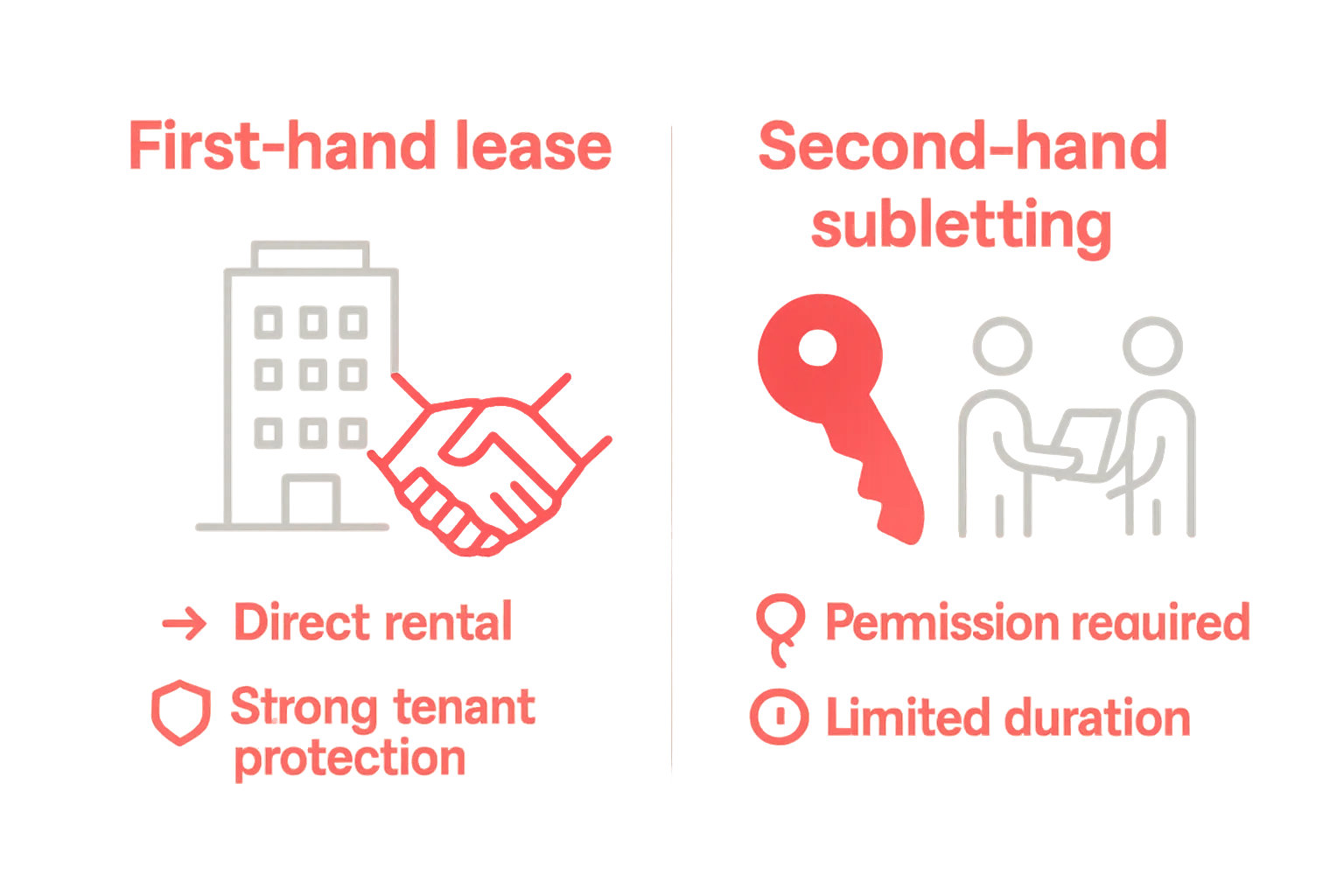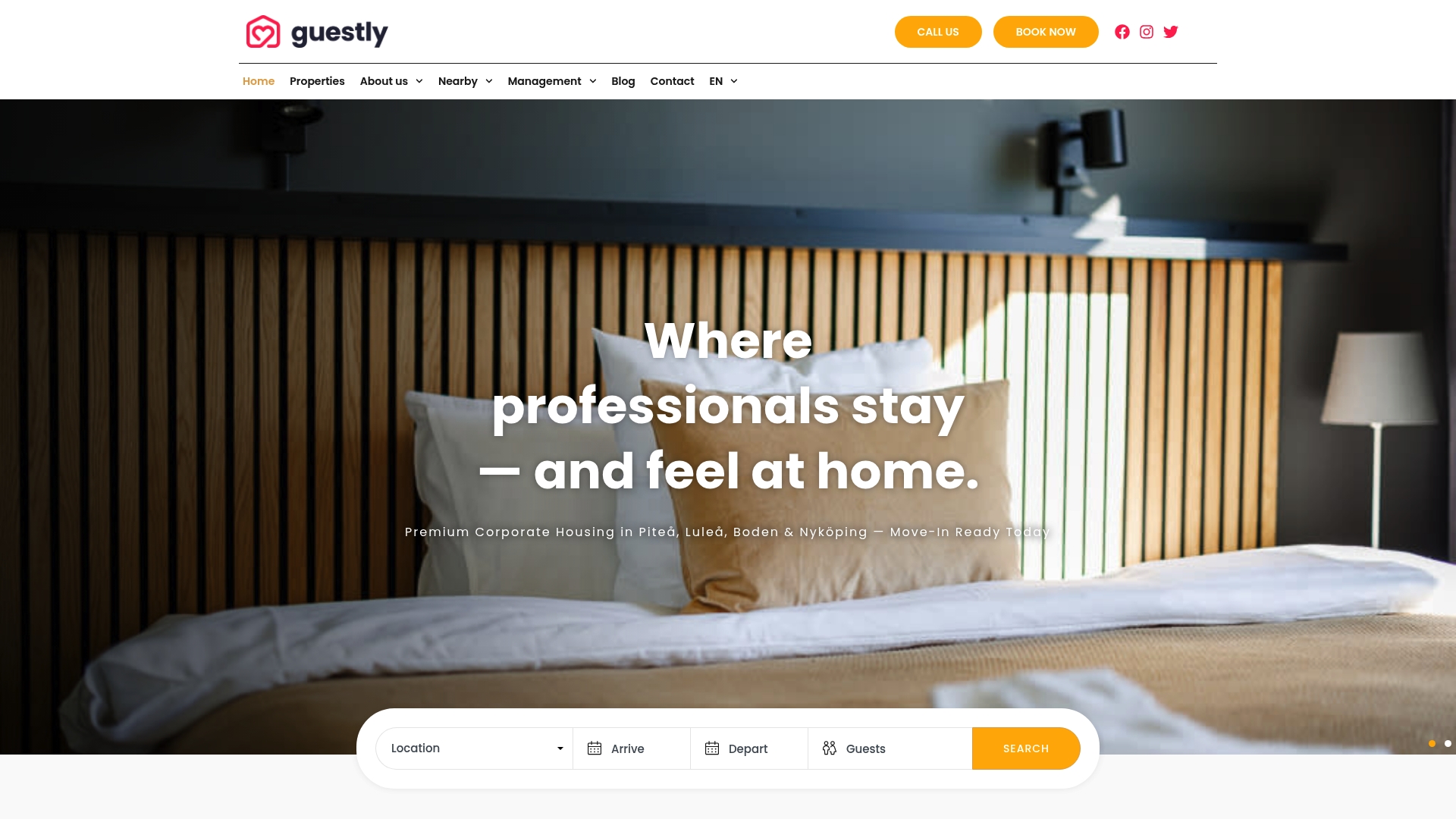Apartment leases are more than simple paperwork. In Sweden, first-hand leases can take up to ten years on a waiting list to secure, leaving many shocked at just how competitive the market is. Yet what actually surprises most tenants is that the real power of a lease lies in its legal protections, not in who gets the keys first.
Table of Contents
- Defining A Lease: What It Is And Its Purpose
- The Importance Of Leases In Rental Agreements
- Key Elements Of An Apartment Lease Document
- How A Lease Protects Property Owners And Tenants
- Common Types Of Apartment Leases In Sweden
Quick Summary
| Takeaway | Explanation |
|---|---|
| A lease is a legal contract. | It formalises the agreement between landlord and tenant, outlining specific terms for property occupancy. |
| Leases protect both parties’ interests. | They establish clear expectations and obligations, minimising misunderstandings and legal disputes. |
| Key lease elements are crucial. | Important components include rental amount, duration, and maintenance responsibilities, ensuring clarity and agreement. |
| Transparency promotes stability. | Clearly defined financial terms and responsibilities foster a stable housing environment and reduce conflicts. |
| Types of leases vary by purpose. | Understanding different lease types, such as first-hand and second-hand leases, helps navigate the rental market effectively. |
Defining a Lease: What It Is and Its Purpose
A lease represents a legally binding contract between a property owner (landlord) and a tenant, establishing the terms and conditions for temporary property occupancy. When exploring what is a lease for an apartment, understanding its fundamental structure and purpose becomes essential for both renters and property owners.
The Legal Foundation of Leasing
At its core, a lease agreement serves as a comprehensive document that outlines the precise parameters of residential tenancy. Unlike verbal agreements, written leases provide clear, enforceable guidelines that protect both parties’ interests. Legal experts at LegalZoom confirm that a robust lease should detail critical components such as:
- Monthly rental amount
- Duration of tenancy
- Security deposit requirements
- Maintenance responsibilities
- Conditions for property use
Purpose and Importance of Lease Agreements
Leases serve multiple crucial functions beyond simple occupancy permission. They establish a formal framework that defines expectations, rights, and obligations for both landlords and tenants.
Legally speaking, a lease agreement provides several key protections:
- Establishes clear financial terms
- Defines boundaries of property usage
- Provides mechanisms for dispute resolution
- Creates predictability for both parties
By formalising the relationship between tenant and property owner, lease agreements minimise potential misunderstandings and provide a structured approach to residential tenancy. Housing and Urban Development research indicates that well-constructed lease agreements significantly reduce potential conflicts and create a stable living environment.
Ultimately, understanding what is a lease for an apartment means recognising it as more than a simple permission to occupy space. It represents a comprehensive legal instrument designed to create transparency, security, and mutual respect in residential arrangements.
The Importance of Leases in Rental Agreements
Leases play a pivotal role in establishing a structured, legally protected relationship between tenants and property owners. Beyond being mere paperwork, these agreements create a framework of mutual understanding and legal accountability that safeguards the interests of both parties.
Legal Protection and Risk Mitigation
A comprehensive lease agreement acts as a critical legal shield for tenants and landlords. Legal experts at Nolo emphasise that well-crafted lease documents can prevent potential disputes by clearly articulating expectations and responsibilities. Key legal protections include:
- Defining precise rental terms
- Establishing clear financial obligations
- Outlining maintenance and repair responsibilities
- Specifying grounds for termination
- Creating mechanisms for conflict resolution
Financial and Operational Transparency
Leases provide a transparent mechanism for financial interactions between tenants and property owners. By documenting rental rates, payment schedules, and additional financial expectations, these agreements eliminate ambiguity and potential misunderstandings. According to Housing Research Foundation, transparent lease agreements contribute significantly to reducing rental-related conflicts and promoting stable housing environments.
Long-term Relationship Management
Beyond immediate legal and financial considerations, leases serve as foundational documents for managing long-term residential relationships. They establish clear boundaries, communicate expectations, and provide a reference point for resolving potential disagreements. Effective lease agreements transform what could be a potentially volatile relationship into a structured, predictable arrangement that benefits both tenants and property owners.
Understanding the importance of leases goes far beyond viewing them as routine paperwork. They represent sophisticated legal instruments designed to create harmony, provide security, and establish clear expectations in residential rental arrangements.
Key Elements of an Apartment Lease Document
Comprehending the specific components of an apartment lease document is crucial for both tenants and landlords. A meticulously constructed lease serves as a comprehensive roadmap defining the parameters of residential tenancy, protecting the interests of all parties involved.
Financial Parameters and Obligations
The financial section forms the cornerstone of any lease agreement. Rental Housing Journal emphasises that this segment must explicitly outline monetary expectations and responsibilities. Critical financial elements include:
- Monthly rental amount and due date
- Security deposit terms and conditions
- Late payment penalties
- Accepted payment methods
- Utility cost allocation
Occupancy Terms and Property Usage
A robust lease document precisely defines the boundaries of property occupation and usage. These terms establish clear guidelines for tenant behaviour and property maintenance. You can explore our detailed guide on long-term apartment rentals for additional insights into comprehensive occupancy agreements. Typical occupancy provisions encompass:
- Maximum number of occupants
- Restrictions on subletting
- Pet policy guidelines
- Noise and behavioural expectations
- Maintenance and repair responsibilities
Legal Protections and Termination Conditions
The legal framework within a lease document provides essential protections for both tenant and landlord. According to Legal Expert Network, these provisions should comprehensively address potential scenarios and dispute resolution mechanisms. Key legal components typically involve:
- Lease duration and renewal options
- Conditions for lease termination
- Notice periods for moving out
- Conflict resolution procedures
- Compliance with local housing regulations
Ultimately, an apartment lease document transcends a mere rental agreement. It represents a sophisticated legal instrument designed to create transparency, establish mutual understanding, and provide a structured framework for residential tenancy.
The key elements of an apartment lease can be complex, so the table below summarises the main components and their importance for both tenants and landlords.
| Element | Description | Importance |
|---|---|---|
| Rental Amount & Due Date | Stated monthly rent and payment deadlines | Ensures financial clarity and budgeting |
| Security Deposit Terms | Conditions and refund process for deposits | Protects against property damage and unpaid rent |
| Duration of Tenancy | Lease length and renewal options | Provides predictability for both parties |
| Maintenance Responsibilities | Defines who maintains and repairs property | Prevents disputes about upkeep duties |
| Property Usage Conditions | Rules on subletting, occupants, pets, behaviour | Maintains property standards and neighbour relations |
| Termination & Notice Periods | How and when lease may be legally ended | Allows for structured move-outs and transition times |
| Conflict Resolution Procedures | Outlines steps for settling disputes | Ensures fair process and legal compliance |
How a Lease Protects Property Owners and Tenants
A lease agreement functions as a critical protective mechanism that establishes clear boundaries and expectations for both property owners and tenants. By creating a comprehensive legal framework, leases mitigate potential risks and provide structured guidelines for residential interactions.
Financial Security Mechanisms
Financial protections are fundamental to lease agreements, offering safeguards for both parties. Tenants Rights Organisation highlights that well-structured leases create predictable economic environments. Key financial protections include:
- Guaranteed rental income for property owners
- Clear payment schedules and expectations
- Defined security deposit terms
- Mechanisms for handling potential defaults
- Transparent fee structures
Legal Risk Mitigation
Leases serve as crucial legal instruments that delineate rights, responsibilities, and potential recourse for conflicts. You can read our comprehensive guide on long-term apartment rentals for deeper insights into legal considerations. According to Housing Legal Experts, lease agreements provide critical legal protections such as:
- Defining precise property usage conditions
- Establishing clear eviction procedures
- Outlining maintenance responsibilities
- Creating dispute resolution frameworks
- Protecting against unilateral contract modifications
Mutual Accountability and Transparency
Beyond financial and legal protections, leases create a framework of mutual accountability. Transparent agreements ensure that both property owners and tenants understand their obligations and rights. This mutual understanding prevents potential misunderstandings and establishes a professional, respectful relationship.

Ultimately, a well-crafted lease transcends a simple legal document. It represents a sophisticated mechanism for creating stability, trust, and predictability in residential arrangements, protecting the interests of both property owners and tenants through clear, comprehensive guidelines.
Common Types of Apartment Leases in Sweden
The Swedish rental market features a nuanced landscape of lease types, each designed to address specific residential needs and legal frameworks. Understanding these variations is crucial for both tenants and property owners navigating the complex rental ecosystem.
First-Hand Lease Contracts
First-hand leases represent the primary form of apartment rental in Sweden. Swedish Land and Housing Authority explains that these contracts involve direct agreements between property owners and tenants in municipally regulated housing. Key characteristics include:
- Direct rental from property owner or housing cooperative
- Strong tenant protection under Swedish law
- Typically longer-term arrangements
- Regulated rental pricing
- Priority access through municipal housing queues
Second-Hand Subletting Arrangements
Second-hand leases provide alternative housing solutions with distinct legal considerations. You can explore our comprehensive guide on corporate leases for additional context. Local Government Regulations indicate these contracts involve:
- Permission required from primary lease holder
- Limited duration typically specified in original contract
- Potential restrictions on rental duration
- Additional legal complexities
- Potential higher rental rates
Corporate and Special Purpose Leases
Corporate leases represent a specialised segment within the Swedish rental market, designed for professional and temporary housing needs. These agreements offer unique flexibility for businesses and professionals requiring short to medium-term accommodation. Distinctive features encompass:
- Tailored for corporate relocation
- Often include furnished options
- More flexible termination conditions
- Potential tax and administrative advantages
- Standardised professional documentation
Ultimately, Swedish apartment leases reflect a sophisticated system balancing tenant protection, housing availability, and market dynamics. Each lease type serves specific residential and professional requirements, demonstrating the complexity of the Swedish housing ecosystem.
To help clarify the distinctions between the main types of apartment leases in Sweden, the following table compares their key characteristics and legal considerations.
| Lease Type | Direct Landlord Agreement | Typical Duration | Legal Protections | Notable Features |
|---|---|---|---|---|
| First-hand Lease | Yes | Long-term | Strong tenant rights | Regulated rent, municipal queue required |
| Second-hand Subletting | No (sublet from tenant) | Limited (as specified) | Additional permissions | Permission needed, higher rent possible |
| Corporate/Special Purpose Lease | Yes (via company) | Short/Medium-term | Professional flexibility | Suits relocations, flexible terms, furnished |

Take Uncertainty Out of Apartment Leasing with Guestly Homes
Searching for stability and trust in your apartment lease? As the article highlighted, navigating complex lease agreements and uncertain expectations often leads to confusion and risk for both tenants and property owners. Many worry about unclear terms, financial surprises, and inconsistent standards—fears that can undermine both comfort and investment.
With Guestly Homes, every aspect of the leasing experience is transparent, reliable, and designed for peace of mind. Our fully managed homes across Sweden deliver legal clarity, financial predictability, and a level of care that turns legal complexity into effortless living or ownership. Whether you are an owner seeking hands-off profitability or a professional needing consistent standards, we bridge the gap with five-star operational excellence you can count on. You can explore how our long-term apartment rentals work and find out how our corporate lease solutions support everything from solo stays to full team relocations.

Ready to leave confusion behind and step into a world where leasing delivers calm and confidence? Visit Guestly Homes today to discover your next fully managed home. Secure the protection and predictability you deserve—start your effortless leasing journey now.
Frequently Asked Questions
What is a lease for an apartment?
A lease for an apartment is a legally binding contract between a property owner and a tenant that outlines the terms and conditions for temporarily occupying the property, including rental amount, duration, and responsibilities.
Why is a lease important for both tenants and property owners?
A lease is important as it establishes clear expectations, rights, and obligations for both parties, providing legal protection and minimizing potential misunderstandings.
What are the key elements included in a lease agreement?
Key elements of a lease agreement include the monthly rental amount, duration of tenancy, security deposit requirements, maintenance responsibilities, and conditions for property use.
How does a lease protect tenants and landlords?
A lease protects tenants and landlords by clearly defining financial terms, property usage conditions, eviction procedures, maintenance responsibilities, and providing mechanisms for conflict resolution.



